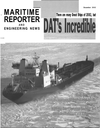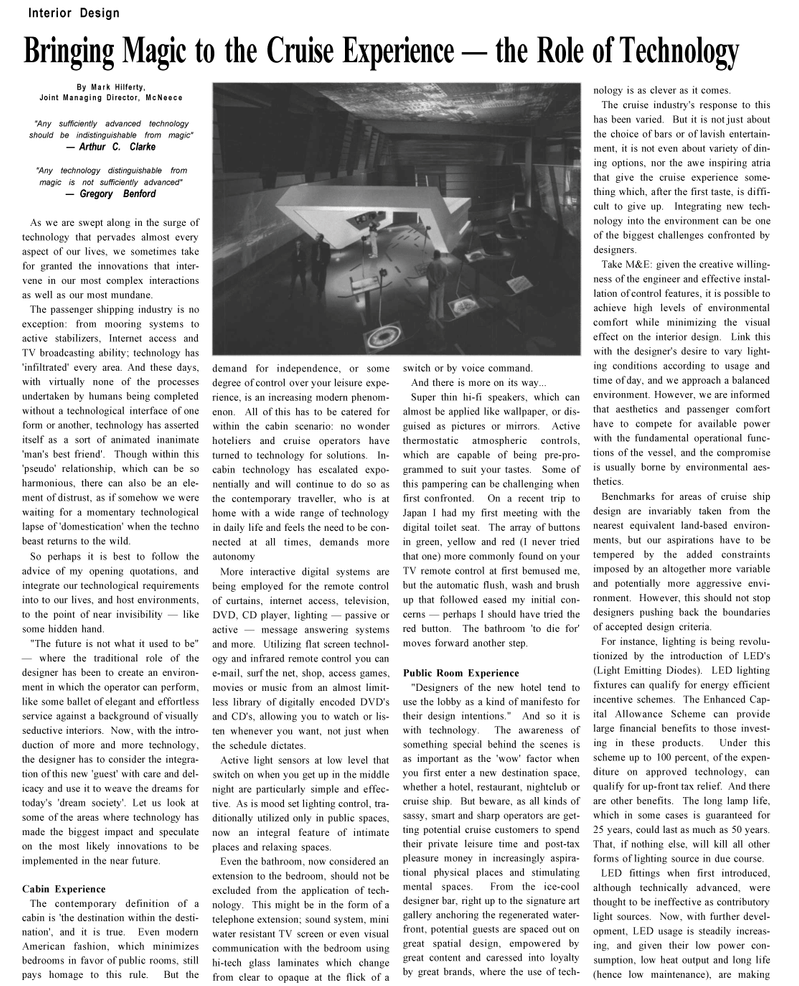
Page 24: of Maritime Reporter Magazine (December 2002)
Read this page in Pdf, Flash or Html5 edition of December 2002 Maritime Reporter Magazine
Interior Design
Bringing Magic to the Cruise Experience — the Role of Technology
By Mark Hilferty,
Joint Managing Director, McNeece "Any sufficiently advanced technology should be indistinguishable from magic" — Arthur C. Clarke "Any technology distinguishable from magic is not sufficiently advanced" — Gregory Benford
As we are swept along in the surge of technology that pervades almost every aspect of our lives, we sometimes take for granted the innovations that inter- vene in our most complex interactions as well as our most mundane.
The passenger shipping industry is no exception: from mooring systems to active stabilizers, Internet access and
TV broadcasting ability; technology has 'infiltrated' every area. And these days, with virtually none of the processes undertaken by humans being completed without a technological interface of one form or another, technology has asserted itself as a sort of animated inanimate 'man's best friend'. Though within this 'pseudo' relationship, which can be so harmonious, there can also be an ele- ment of distrust, as if somehow we were waiting for a momentary technological lapse of 'domestication' when the techno beast returns to the wild.
So perhaps it is best to follow the advice of my opening quotations, and integrate our technological requirements into to our lives, and host environments, to the point of near invisibility — like some hidden hand. "The future is not what it used to be" — where the traditional role of the designer has been to create an environ- ment in which the operator can perform, like some ballet of elegant and effortless service against a background of visually seductive interiors. Now, with the intro- duction of more and more technology, the designer has to consider the integra- tion of this new 'guest' with care and del- icacy and use it to weave the dreams for today's 'dream society'. Let us look at some of the areas where technology has made the biggest impact and speculate on the most likely innovations to be implemented in the near future.
Cabin Experience
The contemporary definition of a cabin is 'the destination within the desti- nation', and it is true. Even modern
American fashion, which minimizes bedrooms in favor of public rooms, still pays homage to this rule. But the demand for independence, or some degree of control over your leisure expe- rience, is an increasing modern phenom- enon. All of this has to be catered for within the cabin scenario: no wonder hoteliers and cruise operators have turned to technology for solutions. In- cabin technology has escalated expo- nentially and will continue to do so as the contemporary traveller, who is at home with a wide range of technology in daily life and feels the need to be con- nected at all times, demands more autonomy
More interactive digital systems are being employed for the remote control of curtains, internet access, television,
DVD, CD player, lighting — passive or active — message answering systems and more. Utilizing flat screen technol- ogy and infrared remote control you can e-mail, surf the net, shop, access games, movies or music from an almost limit- less library of digitally encoded DVD's and CD's, allowing you to watch or lis- ten whenever you want, not just when the schedule dictates.
Active light sensors at low level that switch on when you get up in the middle night are particularly simple and effec- tive. As is mood set lighting control, tra- ditionally utilized only in public spaces, now an integral feature of intimate places and relaxing spaces.
Even the bathroom, now considered an extension to the bedroom, should not be excluded from the application of tech- nology. This might be in the form of a telephone extension; sound system, mini water resistant TV screen or even visual communication with the bedroom using hi-tech glass laminates which change from clear to opaque at the flick of a switch or by voice command.
And there is more on its way...
Super thin hi-fi speakers, which can almost be applied like wallpaper, or dis- guised as pictures or mirrors. Active thermostatic atmospheric controls, which are capable of being pre-pro- grammed to suit your tastes. Some of this pampering can be challenging when first confronted. On a recent trip to
Japan I had my first meeting with the digital toilet seat. The array of buttons in green, yellow and red (I never tried that one) more commonly found on your
TV remote control at first bemused me, but the automatic flush, wash and brush up that followed eased my initial con- cerns — perhaps I should have tried the red button. The bathroom 'to die for' moves forward another step.
Public Room Experience "Designers of the new hotel tend to use the lobby as a kind of manifesto for their design intentions." And so it is with technology. The awareness of something special behind the scenes is as important as the 'wow' factor when you first enter a new destination space, whether a hotel, restaurant, nightclub or cruise ship. But beware, as all kinds of sassy, smart and sharp operators are get- ting potential cruise customers to spend their private leisure time and post-tax pleasure money in increasingly aspira- tional physical places and stimulating mental spaces. From the ice-cool designer bar, right up to the signature art gallery anchoring the regenerated water- front, potential guests are spaced out on great spatial design, empowered by great content and caressed into loyalty by great brands, where the use of tech- nology is as clever as it comes.
The cruise industry's response to this has been varied. But it is not just about the choice of bars or of lavish entertain- ment, it is not even about variety of din- ing options, nor the awe inspiring atria that give the cruise experience some- thing which, after the first taste, is diffi- cult to give up. Integrating new tech- nology into the environment can be one of the biggest challenges confronted by designers.
Take M&E: given the creative willing- ness of the engineer and effective instal- lation of control features, it is possible to achieve high levels of environmental comfort while minimizing the visual effect on the interior design. Link this with the designer's desire to vary light- ing conditions according to usage and time of day, and we approach a balanced environment. However, we are informed that aesthetics and passenger comfort have to compete for available power with the fundamental operational func- tions of the vessel, and the compromise is usually borne by environmental aes- thetics.
Benchmarks for areas of cruise ship design are invariably taken from the nearest equivalent land-based environ- ments, but our aspirations have to be tempered by the added constraints imposed by an altogether more variable and potentially more aggressive envi- ronment. However, this should not stop designers pushing back the boundaries of accepted design criteria.
For instance, lighting is being revolu- tionized by the introduction of LED's (Light Emitting Diodes). LED lighting fixtures can qualify for energy efficient incentive schemes. The Enhanced Cap- ital Allowance Scheme can provide large financial benefits to those invest- ing in these products. Under this scheme up to 100 percent, of the expen- diture on approved technology, can qualify for up-front tax relief. And there are other benefits. The long lamp life, which in some cases is guaranteed for 25 years, could last as much as 50 years.
That, if nothing else, will kill all other forms of lighting source in due course.
LED fittings when first introduced, although technically advanced, were thought to be ineffective as contributory light sources. Now, with further devel- opment, LED usage is steadily increas- ing, and given their low power con- sumption, low heat output and long life (hence low maintenance), are making

 23
23

 25
25
